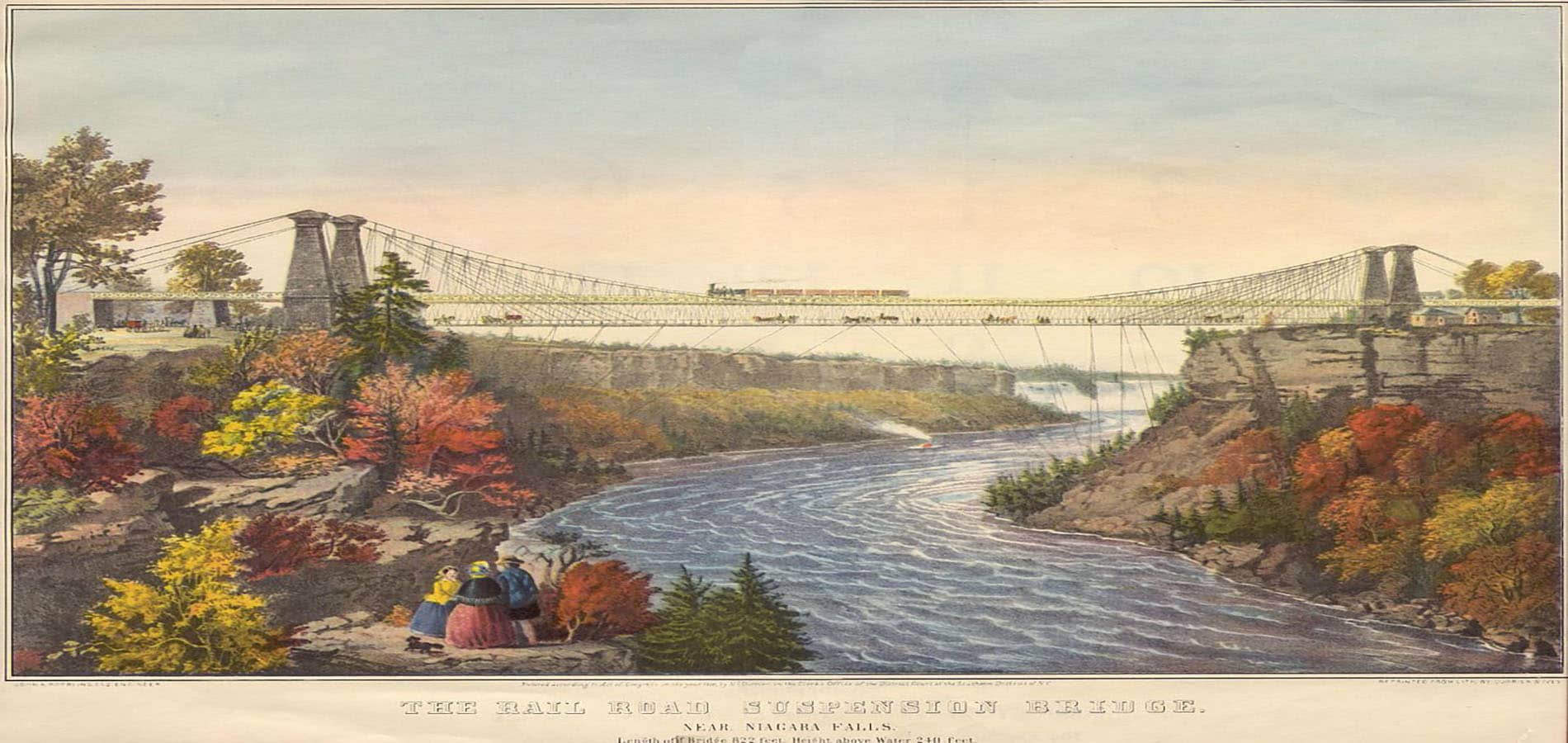On May 19, 1536, the citizens of London gathered around a scaffold at the Tower of London, where the swift chop of a sword brought an end to the life of Anne Boleyn, the second of King Henry VIII’s six wives. Her crime? Failure to bear a son to secure a Tudor successor to the throne of England.
How did it come to be that Anne, greedy and quick-tempered at worst, but no criminal, befell the fate of beheading? Let’s dive into HeinOnline to find out.
A Noble Childhood
Anne Boleyn was the daughter of Thomas Boleyn, later Earl of Wiltshire, and Elizabeth Howard. Her father, a charming diplomat, won the affections of many in good society, including Margaret of Austria, the daughter of the Holy Roman Emperor. Margaret invited Anne to receive an education in her schoolroom, where, though young, she was a well-behaved student who earned Margaret’s ready praise. When she became older, she attended to Henry VII’s sister Mary, who was to marry Louis XII of France.[1]David Hume. History of England, from the Invasion of Julius Caesar to the Revolution in 1688 (1863). This document can be found in HeinOnline’s Legal Classics database. Anne served as a maid of honor to Queen Mary and then to her stepdaughter for several years.
While in France, Anne became acquainted with Marguerite de Navarre, King Francis I’s sister,[2]J. H.; White Merle d’Aubigne, H., Translator. History of the Reformation of the Sixteenth Century (1849-1853). This document can be found in HeinOnline’s Legal Classics database. and other religious reformers who disagreed with the practices of the Catholic Church. This influence would later carry over to Henry VIII’s court.
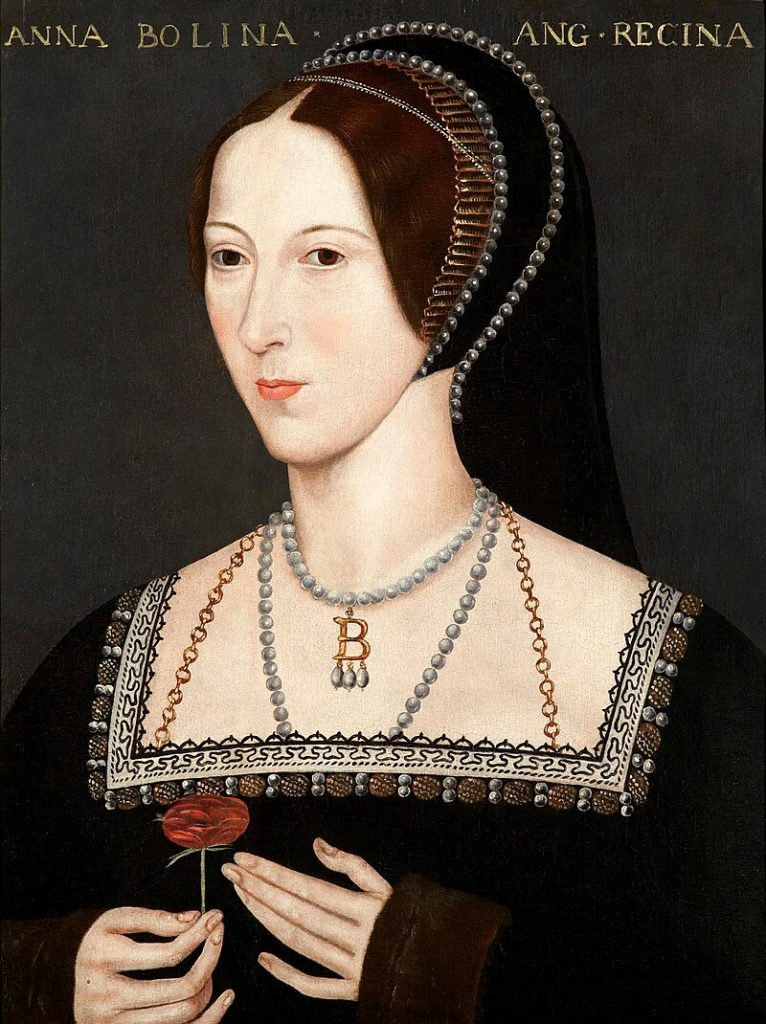
Meanwhile, in 1522, Anne became a lady in waiting to Henry VIII’s first wife, Queen Catherine of Aragon. Anne’s initial debut in court was very successful—her graceful dancing, musical talents, fluency in French, and her sharp wit were noted and drew the attention of many noblemen who competed for her affections. However, a secret betrothal to Henry Percy,[3]Stephen Watson Fullom. History of Woman, and Her Connexion with Religion, Civilization, & Domestic Manners, from the Earliest Period (3). This document can be found in HeinOnline’s Women and the Law database. son of the Earl of Northumberland, was broken off by Percy’s father, who did not approve of the marriage. Anne returned to court, where she became a maid of honor to the queen and befriended several notable people, including poet Sir Thomas Wyatt[4]J. H.; White Merle d’Aubigne, H., Translator. History of the Reformation of the Sixteenth Century (1849-1853). This document can be found in HeinOnline’s Legal Classics database. and Thomas Cromwell.
King vs. Pope
Flirtation was a regular part of court life and was referred to as the game of courtly love. Anne was very good at this game—as was Henry VIII, who began to pursue Anne in early 1526. At first, she refused him, but the king proposed to her in 1527 and she accepted. The one problem? Henry was still married to Catherine.
However, Henry had a plan. Catherine had been previously married to Henry’s brother, Arthur, who died shortly after marriage. Because it was assumed that the marriage had not been consummated, Pope Julius II had allowed the union to be dispensed so that Henry could then marry Catherine. However, Catherine had not borne a son, and Henry took the lack of heir as proof that God did not approve of their relationship.[5]Bailey Acevedo, Mediation between King Henry VIII of England and Pope Clement VII for a Divorce from Catherine of Argon, 7 AM. J. MEDIATION 125 (2013-2014). This article can be found in HeinOnline’s Law Journal Library. Henry was convinced that the current pope, Clement VII, would agree to his reasoning and would annul the marriage. However, he did not. Clement was a prisoner of the Holy Roman Emperor,[6]Ramsay Muir. Short History of the British Commonwealth (1922). This document can be found in HeinOnline’s World Constitutions Illustrated database. who was also Catherine’s nephew. Despite Clement’s refusal, Henry had Catherine removed from court and replaced her with Anne—but while Anne took on some queenly duties, she would not consummate the relationship unless they were married, influenced by her sister Mary who had been a previous mistress of Henry’s.[7]Bailey Acevedo, Mediation between King Henry VIII of England and Pope Clement VII for a Divorce from Catherine of Argon, 7 AM. J. MEDIATION 125 (2013-2014). This article can be found in HeinOnline’s Law Journal Library.
Thomas Cromwell introduced several petitions, including the Supplication against the Ordinaries[8]Howard Jay Graham, Our Tong Maternall Maruellously Amendyd and Augmentyd: The First Englishing and Printing of the Medieval Statutes at Large 1530-1533, 13 UCLA L. REV. 58 (1965). This article can be found in HeinOnline’s … Continue reading and the Submission of the Clergy,[9]English Reports Full Reprint Vol. 155 – Exchequer. This document can be found in HeinOnline’s English Reports database. to English Parliament, to secure the supremacy of the royal family over the Vatican. This effectively created the schism between the Church of England and the Catholic Church.
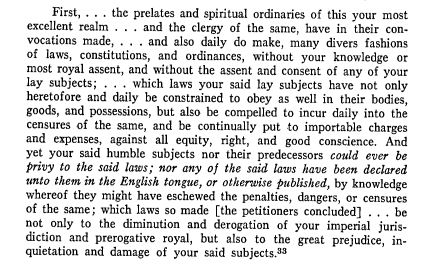
Henry and Anne were secretly married on November 14, 1532, and she became pregnant soon after. They formally married on January 25, 1533. The newly appointed Archbishop of Canterbury, Thomas Cranmer, annulled Henry and Catherine’s marriage[10]Edgar Sanderson. History of the British Empire (1882). This document can be found in HeinOnline’s World Constitutions Illustrated database. and validated Henry and Anne’s. Pope Paul III proceeded to condemn the marriage and excommunicate both Henry and Cranmer,[11]Gilbert William Child. Church and State under the Tudors (1890). This document can be found in HeinOnline’s Religion and the Law database. effectively breaking off the Church of England from the Catholic Church. In fact, Henry’s subjects had to swear an oath[12]Hannis Taylor. Origin and Growth of the English Constitution – An Historical Treatise in Which Is Drawn out, by the Light of the Most Recent Researches, the Gradual Development of the English Constitutional System, and the Growth out of That … Continue reading to reject the Pope and recognize Queen Anne or else face imprisonment. In 1534, Parliament announced that Henry VIII was “the only supreme head on earth of the Church of England.”[13]Henry William; Cripps Cripps, C. A. Practical Treatise on the Law Relating to the Church and Clergy (6). This document can be found in HeinOnline’s Legal Classics database. England was now a Protestant country.
Anne’s Downfall
Everyone expected that Anne’s child would be a boy. To their dismay, on September 7, 1533, she birthed a girl, the future Queen Elizabeth I.[14]John Fox. History of the Lives, Sufferings, and Triumphant Deaths, of the Primitive as Well as the Protestant Martyrs, from the Commencement of Christianity to the Latest Periods of Pagan and Popish Persecution (1853). This document can be … Continue reading
Anne was not very popular among court subjects and the public. She had extravagant taste, spent tons of money, and had a quick temper. Plus, her next pregnancy resulted in a miscarriage.
In early 1536, Catherine of Aragon died. Anne knew that if she didn’t have a son soon, Catherine’s death meant that Henry was free to divorce her and legally marry someone else. And, in fact, Henry already had his eyes on someone: Jane Seymour, one of Anne’s maids-of-honor. Unfortunately, Anne miscarried again—and the child was male.[15]Jonathan K. Van Patten, The Trial of Thomas More – Robert Bolt’s A Man for All Seasons, 68 S.D. L. REV. 73 (2023). This article can be found in HeinOnline’s Law Journal Library. What Henry did to Catherine, he soon did to Anne—he turned his affections onto Jane and moved her into royal quarters.
In April 1536, Henry, motivated by jealousy, affection for Jane, or both, ordered an investigation of Anne,[16]James; et al. Mackintosh. Cabinet History of England, Scotland, and Ireland (1831). This document can be found in HeinOnline’s World Constitutions Illustrated database. accusing her of high treason. Additionally, several men were accused of committing adultery with Anne.[17]Willis J. Abbot. Notable Women in History (1913). This document can be found in HeinOnline’s Women and the Law database. Even Queen Anne’s brother, George Boleyn, was arrested on suspicions of incest[18]Theophilus Camden. Imperial History of England, Accurately and Concisely Compiled from the Best Authorities (1809). This document can be found in HeinOnline’s World Constitutions Illustrated database. and treason. And on May 2, 1536, Anne herself was arrested and imprisoned in the Tower of London.
While in the Tower, Anne wrote one final letter to Henry,[19]Edward Foss. Memories of Westminster Hall: A Collection of Interesting Incidents, Anecdotes and Historical Sketches relating to Westminster Hall, Its Famous Judges and Lawyers and Its Great Trials (1874). This document can be found in … Continue reading part of which read:
But if you have already determined of me, and that not only my death, but an infamous slander must bring you the enjoying of your desired happiness; then I desire of God, that he will pardon your great sin therein, and likewise mine enemies, the instruments thereof, and that he will not call you to a strict account of your unprincely and cruel usage of me, at his general judgment-seat, where both you and myself must shortly appear, and in whose judgment I doubt not (whatsoever the world may think of me) mine innocence shall be openly known, and sufficiently cleared.

The Tragedy Comes to a Head
On May 15, 1536, Anne was tried before a jury[20]Willis J. Abbot. Notable Women in History (1913). This document can be found in HeinOnline’s Women and the Law database. on counts of adultery, incest, and high treason. Sitting on the jury was her own uncle, as well as her former betrothed, Henry Percy. The jury[21]Celebrated Trials, and Remarkable Cases of Criminal Jurisprudence, from the Earliest Records to the Year 1825 (1825). This document can be found in HeinOnline’s World Trials Library. unanimously found her guilty. Two days later, Cranmer annulled Anne and Henry’s marriage.
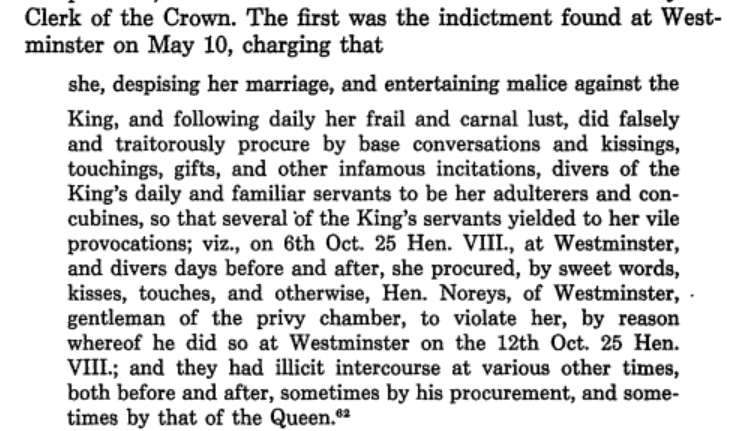
George Boleyn and four other accused men were executed on May 17. Anne was also sentenced to death, and Henry ordered an expert swordsman from France to perform the beheading. As the day neared, Anne was noted as being accepting, and even rather happy. Sir William Kingston, governor of the Tower, noted, “I have seen many men and also women executed, and all they have been in great sorrow, and to my knowledge this lady has much joy and pleasure in death.”[22]Hugh Chisholm, Editor. Encyclopedia Britannica: A Dictionary of Arts, Sciences, Literature and General Information (11). This document can be found in HeinOnline’s Legal Classics database. She even joked about the slenderness of her neck and the skill of the executioner.
The former queen maintained her innocence until the very end. At the scaffold, she addressed the crowd with a brief speech, in which she said, “I pray God save the king and send him long to reign over you, for a gentler nor more merciful prince was there never; and to me he was ever a good, a gentle and sovereign lord.”[23]Hugh Chisholm, Editor. Encyclopedia Britannica: A Dictionary of Arts, Sciences, Literature and General Information (11). This document can be found in HeinOnline’s Legal Classics database. And after a brief prayer, she was beheaded with one stroke of the sword.
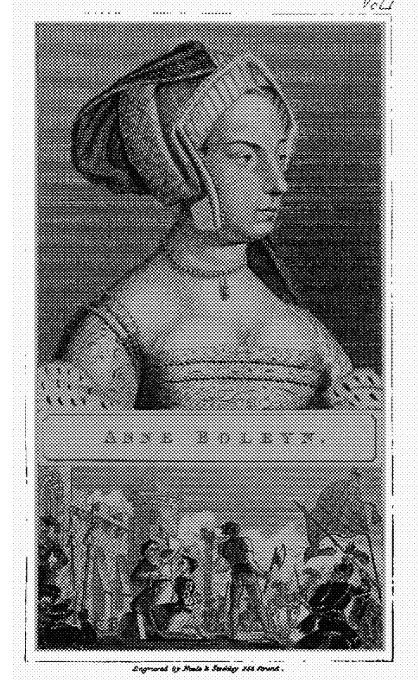
Wasting no time, Henry VIII was married to Jane Seymour just a few days after the beheading.[24]Jonathan K. Van Patten, The Trial of Thomas More – Robert Bolt’s A Man for All Seasons, 68 S.D. L. REV. 73 (2023). This article can be found in HeinOnline’s Law Journal Library. She did bear Henry an heir, but she died soon after childbirth. He would go on to have three more wives: Anne of Cleves, Catherine Howard, and Catherine Parr.
Meanwhile, Anne’s body was buried in the Chapel of St. Peter ad Vincula at the Tower of London.[25]Hugh Chisholm, Editor. Encyclopedia Britannica: A Dictionary of Arts, Sciences, Literature and General Information (11). This document can be found in HeinOnline’s Legal Classics database. Today her grave is marked on the ground of the chapel. All portraits of Anne were ordered to be destroyed by Henry, so there is argument about what Anne might have looked like. However, once Anne’s daughter became queen, Anne was seen as a martyr and an important figure in ushering in the English Reformation. The noted writer John Foxe,[26]Ian Ward, The ‘Great Matter’ of King Henry VIII, 9 J. INT’l DISP. SETTLEMENT 83 (2018). This article can be found in HeinOnline’s Law Journal Library. who depicted Christian martyrs in his Actes and Monuments, particularly venerated Anne, and she remains a figure of interest among historians and the general public today.
Learn More About Famous Trials in HeinOnline
HeinOnline’s World Trials Library is a collection of world trial transcripts and other critical court documents, as well as trial-related resources that analyze and debate the decisions of famous trials. Containing nearly 5,000 titles and more than 2 million pages, this database includes such famous trials as The Nuremberg Trials, John Lawsoin’s American State Trials, Howell’s State Trials, and Law Reports of Trials of War Criminals. It also contains several depictions of the trial of Anne Boleyn (such as this one and this one). With special cooperation from HeinOnline subscribers such as Cornell Law Library, Jenkins Law Library, and the University of Missouri-Columbia Law Library, as well as several antiquarian book sellers, HeinOnline’s World Trials database rivals the holdings of many prestigious libraries around the globe!
HeinOnline Sources[+]
| ↑1 | David Hume. History of England, from the Invasion of Julius Caesar to the Revolution in 1688 (1863). This document can be found in HeinOnline’s Legal Classics database. |
|---|---|
| ↑2, ↑4 | J. H.; White Merle d’Aubigne, H., Translator. History of the Reformation of the Sixteenth Century (1849-1853). This document can be found in HeinOnline’s Legal Classics database. |
| ↑3 | Stephen Watson Fullom. History of Woman, and Her Connexion with Religion, Civilization, & Domestic Manners, from the Earliest Period (3). This document can be found in HeinOnline’s Women and the Law database. |
| ↑5, ↑7 | Bailey Acevedo, Mediation between King Henry VIII of England and Pope Clement VII for a Divorce from Catherine of Argon, 7 AM. J. MEDIATION 125 (2013-2014). This article can be found in HeinOnline’s Law Journal Library. |
| ↑6 | Ramsay Muir. Short History of the British Commonwealth (1922). This document can be found in HeinOnline’s World Constitutions Illustrated database. |
| ↑8 | Howard Jay Graham, Our Tong Maternall Maruellously Amendyd and Augmentyd: The First Englishing and Printing of the Medieval Statutes at Large 1530-1533, 13 UCLA L. REV. 58 (1965). This article can be found in HeinOnline’s Law Journal Library. |
| ↑9 | English Reports Full Reprint Vol. 155 – Exchequer. This document can be found in HeinOnline’s English Reports database. |
| ↑10 | Edgar Sanderson. History of the British Empire (1882). This document can be found in HeinOnline’s World Constitutions Illustrated database. |
| ↑11 | Gilbert William Child. Church and State under the Tudors (1890). This document can be found in HeinOnline’s Religion and the Law database. |
| ↑12 | Hannis Taylor. Origin and Growth of the English Constitution – An Historical Treatise in Which Is Drawn out, by the Light of the Most Recent Researches, the Gradual Development of the English Constitutional System, and the Growth out of That System of the Federal Republic of the United States (1904). This document can be found in HeinOnline’s Legal Classics database. |
| ↑13 | Henry William; Cripps Cripps, C. A. Practical Treatise on the Law Relating to the Church and Clergy (6). This document can be found in HeinOnline’s Legal Classics database. |
| ↑14 | John Fox. History of the Lives, Sufferings, and Triumphant Deaths, of the Primitive as Well as the Protestant Martyrs, from the Commencement of Christianity to the Latest Periods of Pagan and Popish Persecution (1853). This document can be found in HeinOnline’s Religion and the Law database. |
| ↑15, ↑24 | Jonathan K. Van Patten, The Trial of Thomas More – Robert Bolt’s A Man for All Seasons, 68 S.D. L. REV. 73 (2023). This article can be found in HeinOnline’s Law Journal Library. |
| ↑16 | James; et al. Mackintosh. Cabinet History of England, Scotland, and Ireland (1831). This document can be found in HeinOnline’s World Constitutions Illustrated database. |
| ↑17 | Willis J. Abbot. Notable Women in History (1913). This document can be found in HeinOnline’s Women and the Law database. |
| ↑18 | Theophilus Camden. Imperial History of England, Accurately and Concisely Compiled from the Best Authorities (1809). This document can be found in HeinOnline’s World Constitutions Illustrated database. |
| ↑19 | Edward Foss. Memories of Westminster Hall: A Collection of Interesting Incidents, Anecdotes and Historical Sketches relating to Westminster Hall, Its Famous Judges and Lawyers and Its Great Trials (1874). This document can be found in HeinOnline’s World Trials Library. |
| ↑20 | Willis J. Abbot. Notable Women in History (1913). This document can be found in HeinOnline’s Women and the Law database. |
| ↑21 | Celebrated Trials, and Remarkable Cases of Criminal Jurisprudence, from the Earliest Records to the Year 1825 (1825). This document can be found in HeinOnline’s World Trials Library. |
| ↑22, ↑25 | Hugh Chisholm, Editor. Encyclopedia Britannica: A Dictionary of Arts, Sciences, Literature and General Information (11). This document can be found in HeinOnline’s Legal Classics database. |
| ↑23 | Hugh Chisholm, Editor. Encyclopedia Britannica: A Dictionary of Arts, Sciences, Literature and General Information (11). This document can be found in HeinOnline’s Legal Classics database. |
| ↑26 | Ian Ward, The ‘Great Matter’ of King Henry VIII, 9 J. INT’l DISP. SETTLEMENT 83 (2018). This article can be found in HeinOnline’s Law Journal Library. |



